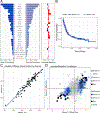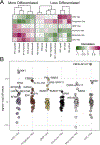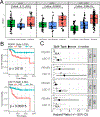Integrative analysis of drug response and clinical outcome in acute myeloid leukemia
- PMID: 35868306
- PMCID: PMC9378589
- DOI: 10.1016/j.ccell.2022.07.002
Integrative analysis of drug response and clinical outcome in acute myeloid leukemia
Abstract
Acute myeloid leukemia (AML) is a cancer of myeloid-lineage cells with limited therapeutic options. We previously combined ex vivo drug sensitivity with genomic, transcriptomic, and clinical annotations for a large cohort of AML patients, which facilitated discovery of functional genomic correlates. Here, we present a dataset that has been harmonized with our initial report to yield a cumulative cohort of 805 patients (942 specimens). We show strong cross-cohort concordance and identify features of drug response. Further, deconvoluting transcriptomic data shows that drug sensitivity is governed broadly by AML cell differentiation state, sometimes conditionally affecting other correlates of response. Finally, modeling of clinical outcome reveals a single gene, PEAR1, to be among the strongest predictors of patient survival, especially for young patients. Collectively, this report expands a large functional genomic resource, offers avenues for mechanistic exploration and drug development, and reveals tools for predicting outcome in AML.
Keywords: JEDI; LSC17; MEGF12; cell state; eigengene; hematologic malignancy; leukemia stem cell; monocyte; targeted therapy.
Copyright © 2022 The Author(s). Published by Elsevier Inc. All rights reserved.
Conflict of interest statement
Declaration of interests C.E.T. receives research support from Notable Labs and serves as a scientific liaison for AstraZeneca. J.E.M. receives research funding from Gilead Pharmaceutical and serves on a scientific advisory board for Ionis Pharmaceuticals. M.W.D. serves on the advisory boards and/or as a consultant for Novartis, Incyte, and BMS and receives research funding from BMS and Gilead. C.S.H. receives research funding from Sellas. T.L.L. consults for Jazz Pharmaceuticals and receives research funding from Tolero, Gilead, Prescient, Ono, Bio-Path, Mateon, Genentech/Roche, Trovagene, AbbVie, Pfizer, Celgene, Imago, Astellas, Karyopharm, Seattle Genetics, and Incyte. D.A.P. receives research funding from Pfizer and Agios and served on advisory boards for Pfizer, Celyad, Agios, Celgene, AbbVie, Argenx, Takeda, and Servier. B.J.D. serves on the advisory boards for Aileron Therapeutics, Aptose, Blueprint Medicines, Cepheid, EnLiven Therapeutics, Gilead, GRAIL, Iterion Therapeutics, Nemucore Medical Innovations, the Novartis CML Molecular Monitoring Steering Committee, Recludix Pharma, the RUNX1 Research Program, ALLCRON Pharma, VB Therapeutics, Vincerx Pharma, and the Board of Directors for Amgen, and receives research funding from EnLiven and Recludix. B.J.D. is principal investigator or co-investigator on Novartis, BMS, and Pfizer clinical trials. His institution, OHSU, has contracts with these companies to pay for patient costs, nurse and data manager salaries, and institutional overhead, but he does not derive salary, nor does his laboratory receive funds, from these contracts. J.W.T. has received research support from Acerta, Agios, Aptose, Array, AstraZeneca, Constellation, Genentech, Gilead, Incyte, Janssen, Kronos, Meryx, Petra, Schrodinger, Seattle Genetics, Syros, Takeda, and Tolero and serves on the advisory board for Recludix Pharma. The authors certify that all compounds tested in this study were chosen without input from any of our industry partners. A subset of findings from this manuscript have been included in a pending patent application.
Figures







Comment in
-
Precision medicine in AML: Function plus -omics is better than either alone.Cancer Cell. 2022 Aug 8;40(8):804-806. doi: 10.1016/j.ccell.2022.07.009. Cancer Cell. 2022. PMID: 35944499
References
-
- Arber DA, Orazi A, Hasserjian R, Thiele J, Borowitz MJ, Le Beau MM, Bloomfield CD, Cazzola M, and Vardiman JW (2016). The 2016 revision to the World Health Organization classification of myeloid neoplasms and acute leukemia. Blood 127, 2391–2405. - PubMed
-
- Armstrong JF, Faccenda E, Harding SD, Pawson AJ, Southan C, Sharman JL, Campo B, Cavanagh DR, Alexander SPH, Davenport AP, et al. (2020). The IUPHAR/BPS Guide to PHARMACOLOGY in 2020: extending immunopharmacology content and introducing the IUPHAR/MMV Guide to MALARIA PHARMACOLOGY. Nucleic Acids Res 48, D1006–D1021. - PMC - PubMed
-
- Avila Cobos F, Vandesompele J, Mestdagh P, and De Preter K (2018). Computational deconvolution of transcriptomics data from mixed cell populations. Bioinformatics 34, 1969–1979. - PubMed
-
- Benjamini Y, and Yekutieli D (2001). The Control of the False Discovery Rate in Multiple Testing Under Dependency. The Annals of Statistics 29, 1165–1188.
Publication types
MeSH terms
Substances
Grants and funding
- U01 CA214116/CA/NCI NIH HHS/United States
- K08 CA245224/CA/NCI NIH HHS/United States
- R01 CA262758/CA/NCI NIH HHS/United States
- R01 CA245002/CA/NCI NIH HHS/United States
- U01 CA217862/CA/NCI NIH HHS/United States
- F30 CA239335/CA/NCI NIH HHS/United States
- P30 CA042014/CA/NCI NIH HHS/United States
- P30 CA069533/CA/NCI NIH HHS/United States
- UL1 TR002369/TR/NCATS NIH HHS/United States
- R01 CA247943/CA/NCI NIH HHS/United States
- U01 CA271412/CA/NCI NIH HHS/United States
- U54 CA224019/CA/NCI NIH HHS/United States
- R01 HL155426/HL/NHLBI NIH HHS/United States
- R01 CA214428/CA/NCI NIH HHS/United States
- K99 CA237630/CA/NCI NIH HHS/United States
- R01 CA229875/CA/NCI NIH HHS/United States
LinkOut - more resources
Full Text Sources
Other Literature Sources

